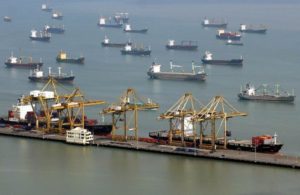 World maritime trade lost momentum in 2018, as volumes grew by only 2.7%, down from the 4.1% growth in 2017 and below the historical averages of 3%, according to a UN Conference on Trade and Development (UNCTAD) report.
World maritime trade lost momentum in 2018, as volumes grew by only 2.7%, down from the 4.1% growth in 2017 and below the historical averages of 3%, according to a UN Conference on Trade and Development (UNCTAD) report.
Despite this, seaborne trade volumes last year amounted to 11 billion tons, a new high, according to the UN Conference on Trade and Development’s (UNCTAD) Review of Maritime Transport 2019.
The report is projecting 2.6% growth in 2019 and an annual average growth rate of 3.4% for the period 2019-2024, driven in particular by growth in containerized, dry bulk and gas cargoes. However, the outlook remains challenging, given the heightened uncertainty regarding trade policy and wide-ranging downside risks clouding the horizon.
“In 2018, world merchandise trade growth decelerated at an unexpected rate, and tariffs on trade between China and the United States of America escalated amid mounting trade tensions and a proliferation of national trade-restrictive measures,” said the report.
Moreover geopolitics and sanctions, environmental concerns, and tensions involving the Strait of Hormuz all contributed to the decelerated growth in merchandise trade.
“The dip in maritime trade growth is a result of several trends including a weakening multilateral trading system and growing protectionism,” said UNCTAD Secretary-General Mukhisa Kituyi.
“It is a warning that national policies can have a negative impact on the maritime trade and development aspirations of all,” he added.
In 2018, global port traffic also slowed down, with container port traffic increasing by only 4.7%, from a 6.7% growth rate in 2017.
Container volumes likewise weakened, only increasing by 2.6% in 2018 compared with 6% in 2017.
Freight rates were further compressed as container fleet supply capacity increased by 6% as compared to 4% in 2017, further saturating an already overly supplied market.
But the liquefied natural gas (LNG) sector expanded as a result of intensified pressure to promote cleaner energy sources, with LNG carriers recording the highest growth rate at 7.25%.
But the report warned that the balance of risks to the outlook remains poor, even with China’s Belt and Road Initiative and the various trade deals that came into force or are in the pipeline.
Moreover, profound structural trends are slowly transforming the maritime transport landscape.
“Other factors that are structural and existential, such as technological disruptions and climate change are at play and are redefining the sector,” said Shamika N. Sirimanne, director of UNCTAD’s division on technology and logistics.
Global maritime transport is increasingly now shaped by new demand and trade patterns, increasing regionalization of supply chains and rebalancing in China’s economy, as well as a larger role of technology and services in value chains and logistics.
The sector is also increasingly facing intensified and more frequent natural disasters and climate-related disruptions.
In the face of these new risks, the industry has embraced an accelerated environmental sustainability agenda, with an increased awareness of the impact of global warming, and the imperative of fast-tracking the energy transition towards cleaner fuel sources.
Important regulatory developments include the global entry into force on January 1, 2020 of the new lower 0.50% limit (from 3.5% currently) on sulfur in ships’ fuel oil.
According to the report, a “new normal” for maritime transport is in the making, and the effects of the paradigm shift are already being felt. Some services, such as those in container shipping and shipbuilding, are consolidating, while others are expanding their scope to include landside and logistic operations.
In addition, some are calling for more governmental support for shipbuilding activities or financing for the technology needed to develop zero-emission vessels.
While adjusting to the new normal may entail some potential challenges, the report observed that it could also open some opportunities. “Supporting this process calls for improved planning, adequate response measures, as well as flexible and forward-looking transport policies that anticipate change.”
Photo By Hernawan Widhi
